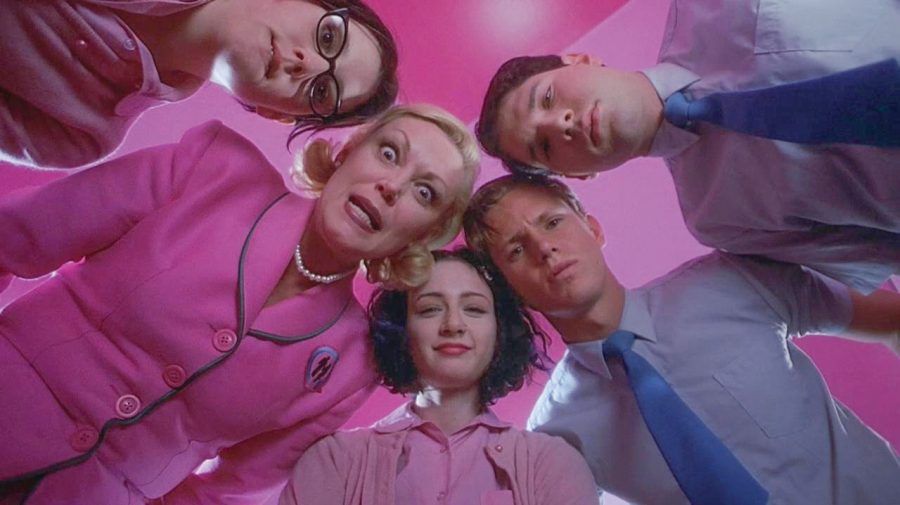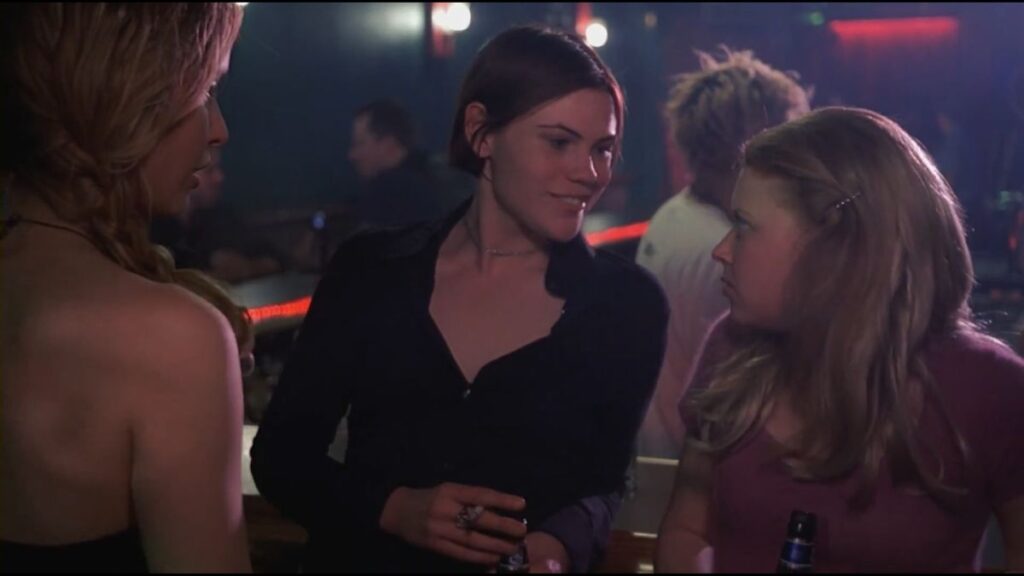On a Thursday evening in October of 2017, I squeezed myself into one of the uncomfortable fold-out auditorium chairs in a screening room at my university. The screening was being thrown by my university’s Film Students Association, which I had just been invited to join by my new, cool friend who I was desperate to impress. I was only a few months into my second year of university, and I was determined to make this year better than my first, which had largely been an overwhelming and isolating experience. The feelings of loneliness were mainly symptoms of the aftermath of a traumatic experience that I’d had in the summer leading up to my first year. Watching Jamie Babbit’s But I’m A Cheerleader for the first time on that Thursday evening was a healing experience.
I’d spent the summer of 2016 volunteering as a counselor at an all-girls Christian summer camp that I had been attending since I was ten years old. In the months leading up to this specific summer at camp, I had started the process of coming out as queer to my close friends and family. I was still trying to unravel all of the complexity of the intersection between my queer identity and my evangelical Christian upbringing.
When the camp administration caught wind of there being openly queer staff members, they launched an investigation to determine whether or not the members of the staff’s values aligned with the anti-LGBTQ beliefs of the administration. After being outed to the administration by someone I trusted, I was told that myself and a good portion of my peers would not be welcome back to the camp if we did not align with the organization’s beliefs that relationships outside of those between a man and a woman were sinful. Essentially, I was faced with the choice to condemn the aspects of my identity that had brought me a sense of peace and confidence in myself for the first time in my life, or say goodbye to the community that had helped form who I was up until this point.
Now here I was, a year after my experience at camp, and still untangling all of the layers of grief, rejection, and shame that I was feeling. I had chosen film as my major because consuming, dissecting, and obsessively thinking about movies is all I’ve ever known how to do. I’ve always used movies as a tool for navigating messy feelings, and after one of the most difficult years of my life, But I’m a Cheerleader came to me in all its sugar-sweet, pastel-coated glory at exactly the moment I needed it.
But I’m a Cheerleader follows Megan (Natasha Lyonne), a high school cheerleader who is sent away to a reparative program called True Directions after her family and friends hold an intervention to address her ‘homosexual behaviors.’ True Directions is run by no-nonsense director Mary Brown (Cathy Moriarty) and a proud “ex-gay” instructor, Mike (RuPaul Charles), who use a five-step program to convert the program’s participants to heterosexuality.

Director Jamie Babbit credits an article about reparative therapy (also known as conversion therapy) as part of her inspiration for the film. Reparative therapy is an extremely harmful, and unfortunately common practice that targets LGBTQ+ youth and aims to change their sexual orientation, gender identity, or gender expression. Babbit brought screenwriter Brian Wayne Peterson on to develop the script, as Peterson had personally witnessed the effects of reparative therapy while working at a prison clinic for sex offenders.
But I’m a Cheerleader is the kind of movie that you feel like you shouldn’t be laughing, but its strength lies in its ability to revel in that discomfort. Despite its difficult subject matter, BIAC is incredibly fun. The characters are immersed in a technicolor world of plastic and polyester. True Directions is hosted in an extravagant pink life-sized dollhouse with brightly-painted interiors. It’s a bright, dreamy scene, but a strictly gendered one. At True Directions, everything from the activities to the participants’ uniforms are meant to conform to traditional gender norms. The boys, donned in baby blue, are led by Mike, who teaches them the fundamentals of being a man: fixing a car, swinging an axe, perfecting the crotch-grab. All the while, the girls are dressed in Barbie pink while Mary leads them through various domestic activities like housework and swaddling baby dolls.
On her first day at True Directions, Megan is introduced to the eccentric group of teenage participants, including the overly eager Hilary (Melanie Lynskey) and the brooding, judgemental Graham (Clea Duvall). Megan’s first task, like everyone else’s at True Directions, is to admit that she’s gay. At first, she’s in vehement denial that she’s anything but a picture-perfect All-American heterosexual – she’s a cheerleader after all! But the other participants probe her further about her vegetarian lifestyle and her bedroom full of posters of women, hilariously highlighting decades-old stereotypes about lesbianism. As a result, Megan comes to the shocking, devastating realization that she is, in fact, a homosexual. She cries and chants “I’m a homosexual” in despair as her peers comfort her. Though stereotypes can be damaging to the broader cultural understanding of queerness, Babbit playfully leans into these tropes, inviting us to laugh at the silliness of it all. This scene perfectly encapsulates the way that Babbit uses the exuberant, over-the-top elements of camp to cut the tension of a scene that so devastatingly mirrors the experience of many queer folks who have lived through reparative therapy.
One of my favourite lines in But I’m a Cheerleader comes from Mary, who greets Megan and her parents upon their arrival to True Directions. Megan confirms that she is seventeen, and Mary tells Megan’s parents, “You almost lost her to college! You know, it’s so much harder after they’ve been through all that liberal arts brainwashing.”

I was around the same age as Megan during my own traumatic summer. I had just finished high school and would be heading off to university in the fall. As both of us experienced such a painful rejection at the hands of communities that we trusted, it’s hard not to see myself reflected in Megan’s despair at the beginning of the film. However, like Megan, I possess a sense of ruthless optimism that forced me to find and grasp onto hope in such a challenging situation.
I think my fateful summer at camp would have been unbearably isolating if it weren’t for the beautiful irony that a lot of the other staff around me were also queer. How shocking that an all-girls overnight camp with an unspoken dress code of Birkenstocks and Bermuda shorts was full of queer folks! Because of this, despite the overwhelming anger and grief that we were all experiencing, we were in it together. That summer, we spent much of our spare time huddled together on stiff twin mattresses, chewing on tuck shop chocolate bars, crying, praying, and laughing together. Sometimes it was hard to discern if we were shedding tears of grief or laughter. All we had were our inside jokes, shared glances, and giggle fits to coax us through the deeply painful absurdity of what we were going through.
When you’re immersed in an environment that is dedicated to making you feel ashamed about your identity, it’s easy to start to believe that maybe they’re right. I often think about how that summer would have gone if I was the only queer person during that experience. I think if it weren’t for the fact that I had a community of peers to unravel it all with, I may have drowned in that shame. Instead, my friends and I dedicated our spare moments to finding little pockets of queer joy in a space that was so bent on denying it from us. We developed a secret code of layered inside jokes, we made each other rainbow friendship bracelets and held each other’s hands through it all. Fortunately, having that support system meant that somehow, during one of the most deeply traumatic formative experiences of my life, I came out on the other side feeling more affirmed and validated in my identity than I did before.
The way I experienced the healing power of queer friendship that summer mirrors that of Megan’s time at New Directions. Despite Megan’s family and friends sending her off to True Directions with the hopes of making her straight, it actually becomes the place where she finds community with other queer teens for the first time. Only by being sent somewhere meant to deny her truth does Megan come to terms with her queer identity.
One night, once the camp leaders are asleep, Megan and a handful of the other True Directions kids sneak out for a night at the local gay bar. This marks Megan’s first experience in a deliberately and unapologetically queer space, where queer folks all around her are dancing, kissing, and drinking freely. I’m reminded of my first time at a gay bar after moving to the big city for university. In the wake of my summer of heartbreak, I remember the heart-skipping excitement I felt seeing people like me all around, being blissfully, authentically queer.
At the bar, an overwhelmed Megan starts muttering mantras under her breath to rid herself of “temptation.” Graham tells her, “You don’t have to do that. Just be yourself.” Up until then, Megan has spent the entire film holding her breath, calculating her every movement, trying desperately to assimilate. But here, in a gay dive bar hilariously named The Cocksucker, she can finally be herself. Watching this scene for the first time, I felt that same relief.

There is something so cathartic about a story like But I’m a Cheerleader that marries realism with silly, limitless fun. But I’m a Cheerleader doesn’t shy away from showing us the truth about the harmful and devastating reality of anti-LGBTQ+ institutions like reparative therapy, but it packages it in a deliciously campy, candy-coated romantic comedy.
I saw BIAC nearly two decades after its original release, and yet Jamie Babbit’s feature directorial debut met me exactly where I was, and harbored the healing power of uncontainable belly-laughter to help me cope with the grief I was experiencing. Babbit creates a silly spectacle of the kind of homophobic rhetoric that fuels practices like reparative therapy, while allowing her characters to pridefully overcome it all. There really is something so joyful about seeing a triumphant Megan crash the True Directions closing ceremony in a lesbian-flag-coloured cheerleading outfit to serenade her girlfriend her away to an uncertain but gleeful queer existence. In But I’m a Cheerleader, the characters’ joy comes from their ability to see, know, and love each other for all that they are. To me, this is a holy kind of love – the kind of love I’d been desperate to find after facing rejection at the hands of a faith community that claimed but failed to show me unconditional love.



